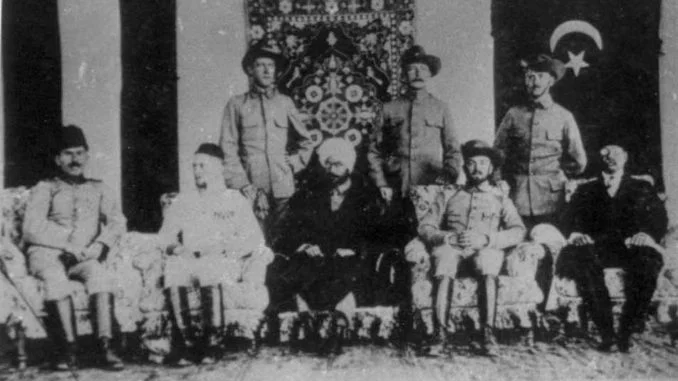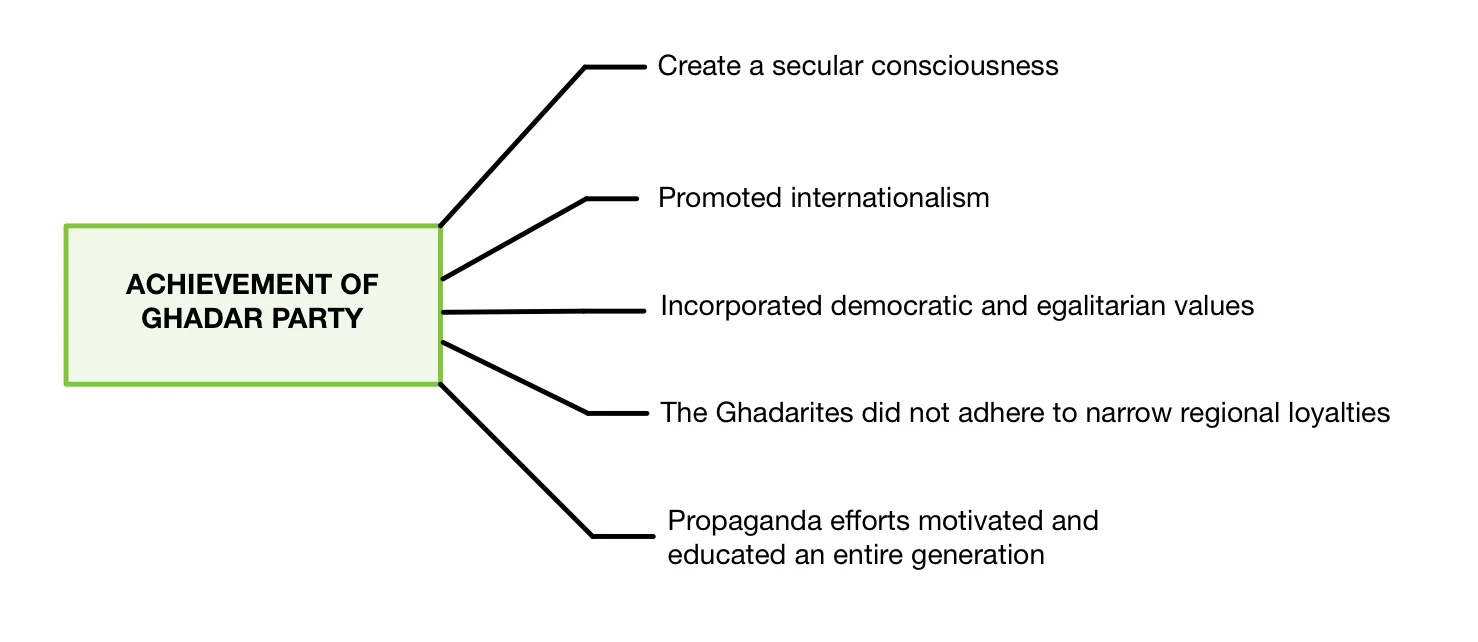The Ghadar Party was a revolutionary organization centred on the weekly newspaper “The Ghadr,” which had branches in the Far East and along the US coast in addition to its San Francisco headquarters. Before the formation of the Ghadar Party, earlier revolutionary activities were carried out by individuals such as Ramdas Puri, G.D. Kumar, Taraknath Das, Sohan Singh Bhakna, and Lala Hardayal, who arrived in the United States in 1911. These earlier activists had established the ‘Swadesh Sevak Home’ in Vancouver and the ‘United India House’ in Seattle to facilitate their revolutionary activities. Finally, in 1913, the Ghadar Party was officially founded.

Unfulfilled Dream of Punjab’s Revolt
This incident, combined with the outbreak of the First World War, incited the leaders of the Ghadar Party to plan a violent attack aimed at ousting British rule in India. Amidst the unfolding events, a crucial meeting of the prominent activists of the Ghadar Movement recognized the urgency of the situation. They believed it was imperative to seize the moment, even if it meant risking their lives. Their primary obstacle, the lack of arms, was viewed as a challenge that could be overcome by going to India and rallying Indian soldiers to their cause. In response, they issued and widely circulated the Ailan-e-Jung or Proclamation of War of the Ghadar Party.
- Leadership and Mobilization Efforts: Leaders such as Mohammed Barkatullah, Ram Chandra, and Bhagwan Singh organized and spoke at a series of public meetings to inspire Indians to return to India and orchestrate an armed revolt.
- Global Outreach: Notably, key figures were dispatched to encourage Indians residing in Japan, the Philippines, China, Hong Kong, the Malay States, Singapore, and Burma to come back to India and join the revolutionary movement.
- Early Initiatives: Some of the more impulsive Ghadar activists, including individuals like Kartar Singh Sarabha (who was later executed by the British in a conspiracy case) and Raghubar Dayal Gupta, left immediately for India to take action.
- Government Surveillance: The British government had full knowledge of the Ghadar Movement’s plans, which were not well-concealed secrets. In anticipation of the returning emigrants, the government invoked the Ingress into India Ordinance.
- Upon their arrival, emigrants were carefully screened, with those considered “safe” allowed to proceed to their homes, those deemed “dangerous” arrested, and the “less dangerous” ones instructed not to leave their home villages.
- Evading Detection and Fostering Rebellion in Punjab: Of course, some of the more “dangerous” individuals managed to evade detection and reach Punjab to incite rebellion.
- Out of approximately 8,000 returnees, 5,000 encountered no hindrance, roughly 1,500 faced precautionary measures, and some who arrived via Colombo and South India made it to Punjab without being identified.
However, the Ghadar Movement found that Punjab in 1914 was not receptive to their cause. The local population was not inclined to participate in the romanticised adventure of the Ghadar. Despite their efforts, which included village tours and addresses at gatherings, the Ghadarites faced widespread disillusionment. The Chief Khalsa Diwan, affirming its loyalty to the British crown, declared them “fallen Sikhs” and criminals and cooperated with the government to locate and apprehend them.
- Frustrated with the response of civilians, the Ghadarites shifted their focus to the army.
- In November 1914, they made several naive attempts to instigate mutinies among army units. However, the absence of organised leadership and central command hindered their efforts.
- Desperate to find a leader, they contacted Bengali revolutionaries and through the efforts of Sachindranath Sanyal and Vishnu Ganesh Pingley, Rash Behari Bose, the renowned Bengali revolutionary who had previously attacked the Viceroy Hardinge, arrived in Punjab in mid-January 1915 to lead the revolt.
- Rash Behari Bose established a rudimentary organisation and sent out emissaries to contact army units in various locations, from Bannu in the North-West Frontier to Faizabad and Lucknow in the United Provinces (U.P.).
- They were instructed to report back by February 11, 1915, and the mutiny was initially set for February 21, later revised to February 19, 1915. Unfortunately, the Criminal Investigation Department (CID) had successfully infiltrated the organisation, from high-ranking members to lower levels, and the government preempted their actions effectively.
- Most leaders were arrested, although Bose managed to escape.

Essentially, the Ghadar Movement was quelled, and the government went further by conducting conspiracy trials in Punjab and Mandalay. Forty-five revolutionaries were sentenced to death, and more than 200 received lengthy prison terms. This marked a significant blow to the nationalist leadership in Punjab.
- Some Indian revolutionaries who operated from Berlin, maintaining connections with Ghadar leader Ram Chandra in America, continued with German support to attempt organising mutinies among Indian troops stationed abroad.
- Raja Mahendra Pratap and Barkatullah sought the assistance of the Amir of Afghanistan and even established a Provisional Government in Kabul, but these efforts did not yield significant success. It seemed that violent opposition to British rule was doomed to failure.
In response to the wartime threat, the British enacted a comprehensive array of repressive measures, the most extensive since 1857. Most notably, the Defence of India Act was passed in March 1915, primarily to crush the Ghadar movement. This period saw large-scale detentions without trial, the establishment of special courts that imposed extremely severe sentences, and numerous court-martials of army personnel. Besides the Bengal revolutionaries and the Punjab Ghadarites, radical pan-Islamists like the Ali brothers, Maulana Azad, and Hasrat Mohani were interned for years.
Evaluation of Ghadar
The Ghadar Movement may not have achieved its stated objectives of driving out the British from India, but it can hardly be considered a failure. The success or failure of a political movement should not solely be measured by the immediate attainment of its goals. When viewed in terms of the deepening of nationalist consciousness, the evolution and testing of new strategies and methods of struggle, and the creation of traditions of resistance, secularism, democracy, and egalitarianism, the Ghadarites made a significant contribution to India’s struggle for independence.
Achievement of the Ghadar Party
- Critique of colonialism: One of the most significant successes of the Ghadar Movement was in the realm of ideology. Through their publications, particularly “The Ghadar,” they disseminated the entire nationalist critique of colonialism in a powerful and simple form to a broad audience of Indian immigrants, including many poor workers and agricultural labourers.
- This extensive propaganda effort motivated and educated an entire generation.
- Create a secular consciousness: Despite the majority of Ghadar leaders and participants being Sikhs, the ideology promoted by the movement was strongly secular in tone. The movement consciously sought to create a secular consciousness among Punjabis and Indians at large.
- This secular outlook was evident in the movement’s embrace of the nationalist salute “Bande Mataram” and its promotion of the idea that religion lay not in outward forms but in adhering to principles of good behaviour found in various religious teachings.

- Broader regional loyalties: The Ghadarites did not adhere to narrow regional loyalties and welcomed leaders like Lokamanya Tilak, Aurobindo Ghose, Khudi Ram Bose, Kanhia Lal Dutt, and Savarkar as heroes.
- Regional and ethnic identities were not emphasised; instead, the emphasis was on the idea that the Punjabis had a debt to repay Bharat Mata for their role in 1857 by fighting for her honour.
- Democratic and egalitarian values: The Ghadar Movement incorporated democratic and egalitarian values. The movement’s objective was the establishment of an independent Indian republic.
- The influence of anarchist, syndicalist, and socialist ideas, especially those of Har Dayal, contributed to an egalitarian ideology within the movement.
- This ideology later facilitated the transformation of many Ghadarites into peasant leaders and Communists in the 1920s and 1930s.
- Promoted internationalism: Har Dayal, one of the key figures of the movement, also promoted internationalism among Ghadar revolutionaries.
- They looked to international revolutionary movements for inspiration, such as the Mexican revolutionaries.
- This internationalist outlook added to the Ghadar Movement’s distinctive character, marked by its secular, egalitarian, democratic, and non-chauvinistic values.
Weakness of the Ghadar Party
The Ghadar Movement indeed had its share of weaknesses that contributed to its inability to achieve its objectives. Some of the major weaknesses of the movement include:
- Underestimation of Preparation: The movement underestimated the degree of preparation required at various levels, including organisational, ideological, financial, and tactical strategy.
- The Ghadar leaders, carried away by their patriotic fervour and emotional state after incidents like the Komagata Maru episode, underestimated the extensive preparation required at every level.
- They failed to recognize the vast difference between mobilising a few thousand discontented immigrant Indians abroad and the monumental task of mobilising and motivating millions of peasants and soldiers in India.
- The leaders overestimated the impact a mere call for revolt would have on British rule.
- Lack of Effective Leadership: The Ghadar Movement struggled to generate effective and sustained leadership capable of unifying the various aspects of the movement.
- Har Dayal, a key figure in the movement, was more of a propagandist and ideology than an organizer.
- His ideas were not a structured whole, and his departure from the U.S. at a crucial stage left his compatriots without a clear leader.
- Weak Organisational Structure: The movement suffered from a weak organisational structure. It relied heavily on the enthusiasm and commitment of the militants but lacked an effective organisational setup to coordinate their efforts.
- It is possible that Lala Hardayal, one of the prominent figures in the Ghadar movement, may not have been ideally suited for the role of an organiser.
Implication of Weakness of the Ghadar Party
These weaknesses led to a significant loss of human resources. Many Ghadarites were sentenced to death or long prison terms. The movement’s failure to maintain a cohesive leadership and organisation meant that an entire generation of secular nationalist leaders was politically beheaded. Had these leaders remained politically effective, they could have significantly influenced the political landscape of Punjab and acted as a bulwark against the growth of communal tendencies that emerged in later years.
| Must Read | |
| Current Affairs | Editorial Analysis |
| Upsc Notes | Upsc Blogs |
| NCERT Notes | Free Main Answer Writing |
Conclusion
It’s important to note that the Ghadar Movement’s legacy lived on. In the late 1920s and 1930s, some surviving Ghadarites played a role in laying the foundations of a secular national and peasant movement in Punjab. Their strong secular moorings continued to influence Punjab’s political landscape and helped counteract communal tendencies. The Ghadar Party’s efforts, though unsuccessful in their immediate goal of ending British rule, profoundly influenced India’s nationalist consciousness. Their dedication to secularism, democracy, and egalitarianism left a lasting legacy, even as organizational weaknesses led to their eventual downfall.
Sign up for the PWOnlyIAS Online Course by Physics Wallah and start your journey to IAS success today!
| Related Articles | |
| Indian Response to First World War & Home Rule Movement | Defence Technology |
| The Revolt of 1857 | Ghadar Party |

 GS Foundation
GS Foundation Optional Course
Optional Course Combo Courses
Combo Courses Degree Program
Degree Program












